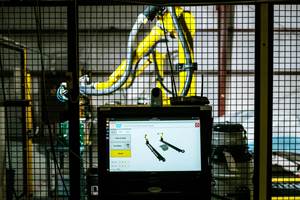An autonomous future for composites?
Autonomous transportation is coming, whether we like it or not. Composites should play a significant role.
In July of 2013, the title of this column was “.” At the time, I postulated that the F-35 would be the last manned fighter aircraft developed by the US, and that future versions will be unmanned, perhaps piloted (or guided) remotely by ground-based operators, out of harm’s way. I still believe that will be the case, and earlier in 2017, the US Air Force demonstrated autonomous combat capabilities with specially outfitted F-16 aircraft, complementing other developments in this area.
In parallel, there have been numerous developments in autonomous vehicles for ground transportation. Many are familiar with the self-driving technology recently introduced by Tesla (Palo Alto, CA, US), a major step toward true autonomous operation. The physical driver has not been eliminated, but for much of the trip, the operator can let the vehicle steer, accelerate and brake toward the destination. Google has been testing driverless cars, and ride-share company Uber conducted similar tests in Pittsburgh, San Francisco and Phoenix earlier this year, with mixed results (some accidents were caused by human drivers of other cars). Several companies are already testing driverless semi-trucks, and France’s SNCF has announced plans to test autonomous trains on its famous TGV lines sometime in 2019. Although there are still many issues yet to be resolved, autonomous transportation is coming, whether we like it or not.
Last year, ride-share operator Lyft predicted that a majority of its trips will be self-driving by 2021 and, recently, that it will provide more than 1 billion rides per year using autonomous electric vehicles by 2025. I see real opportunity for autonomous taxi services, especially for children and senior citizens, given that the former are not licensed to drive and the latter could benefit from not having to drive, when eyesight or other physical abilities are impaired. Today, one can use a phone app, such as those provided by Uber or Lyft, to request a vehicle to transport children to or from music practice, as well as to after-school jobs, without inconveniencing a parent. Similarly, a senior citizen can use the service to see their physician, go shopping or attend a social event with friends or family. While convenient, today’s fleet of driver-owned vehicles is somewhat expensive for “everyday” trips, and a fleet of custom-designed, autonomous electric vehicles could perform such services more economically. How? Look at battery costs. According to a 2017 report from Benchmark Minerals (London, UK), costs of lithium-ion batteries have dropped from US$542 per kw-hr in 2012 to US$139/kw-hr today, and are expected to fall below $100/kw-hr by 2020. Based on this, Bloomberg sees the costs of battery-electric vehicles equaling gasoline-powered cars by 2025.
What role might composites play in this autonomous future? First, unless battery chemistry changes, there is not much room for improvements in power density for lithium-ion technology. Even if batteries become “cheap as chips,” they will still be heavy, creating lightweighting opportunities for composites to extend driving range. Second, in autonomous electric vehicles, power source storage in the floor and the lack of a driver expands the interior design space. Passengers could sit facing each other, and cars could travel bidirectionally. Vehicles might feature multiple entertainment options, or screens that allow a student to log on, using biometric data, and work on her homework on the way to or from soccer practice. Composites here o er styling improvements metals can’t: soft-to- the-touch appearance and the ability to create a modern “feel.”
What about crash energy management and repair, which are oft-cited drawbacks to composites in automobiles? Autonomous vehicles eventually will be equipped with extensive sensors that enable them to maintain appropriate distance from other vehicles, and they’ll have crash avoidance technology, making impacts and repairs significantly less frequent. However, driverless cars cannot control the actions of human drivers in conventional vehicles, so autonomous vehicles will need, at least for a decade or more, to be built to withstand crash situations, partially through structure, and with predictive passenger protection, such as airbags that in ate before impact, rather than after. Such technologies are already being deployed on many conventional cars to automatically brake or steer clear for increasingly distracted human drivers.
Autonomous local passenger transport may not be limited to the ground. Airbus has released a video demonstrating how a pilotless “flying taxi,” using vertical takeoff and landing (VTOL) technology, could supplant intermediate-distance commutes, hinting at a prototype by the end of 2017. No doubt these flying machines will be composites-intensive. It seems the future is autonomous travel, and composites should play a big role, on the ground and in the air.
Related Content
Optimizing robotic winding of composite tanks and pipes
Pioneer in mandrel-based reinforced rubber and composite products, TANIQ offers TaniqWindPro software and robotic winding expertise for composite pressure vessels and more.
Read MoreAI-powered robotic solutions support high-mix manufacturing
AI startup offers automation innovations for high-mix, high-variability, manual surface finishing applications.
Read MoreAES explores robot vs. gantry for large-format additive manufacturing
Additive Engineering Solutions, specialist at 3D printing very large parts and tools on gantry machines, now also uses a robot for large-format AM. Here is how the robot compares.
Read MoreFlyber launches U.K. composites manufacturing site for advanced mobility applications
The startup’s design automation and composite material layup and curing technologies target lightweighting for aerospace, UAVs, eVTOL and high-performance mobility platforms.
Read MoreRead Next
Ceramic matrix composites: Faster, cheaper, higher temperature
New players proliferate, increasing CMC materials and manufacturing capacity, novel processes and automation to meet demand for higher part volumes and performance.
Read MoreCutting 100 pounds, certification time for the X-59 nose cone
Swift Engineering used HyperX software to remove 100 pounds from 38-foot graphite/epoxy cored nose cone for X-59 supersonic aircraft.
Read MoreScaling up, optimizing the flax fiber composite camper
Greenlander’s Sherpa RV cab, which is largely constructed from flax fiber/bio-epoxy sandwich panels, nears commercial production readiness and next-generation scale-up.
Read More











